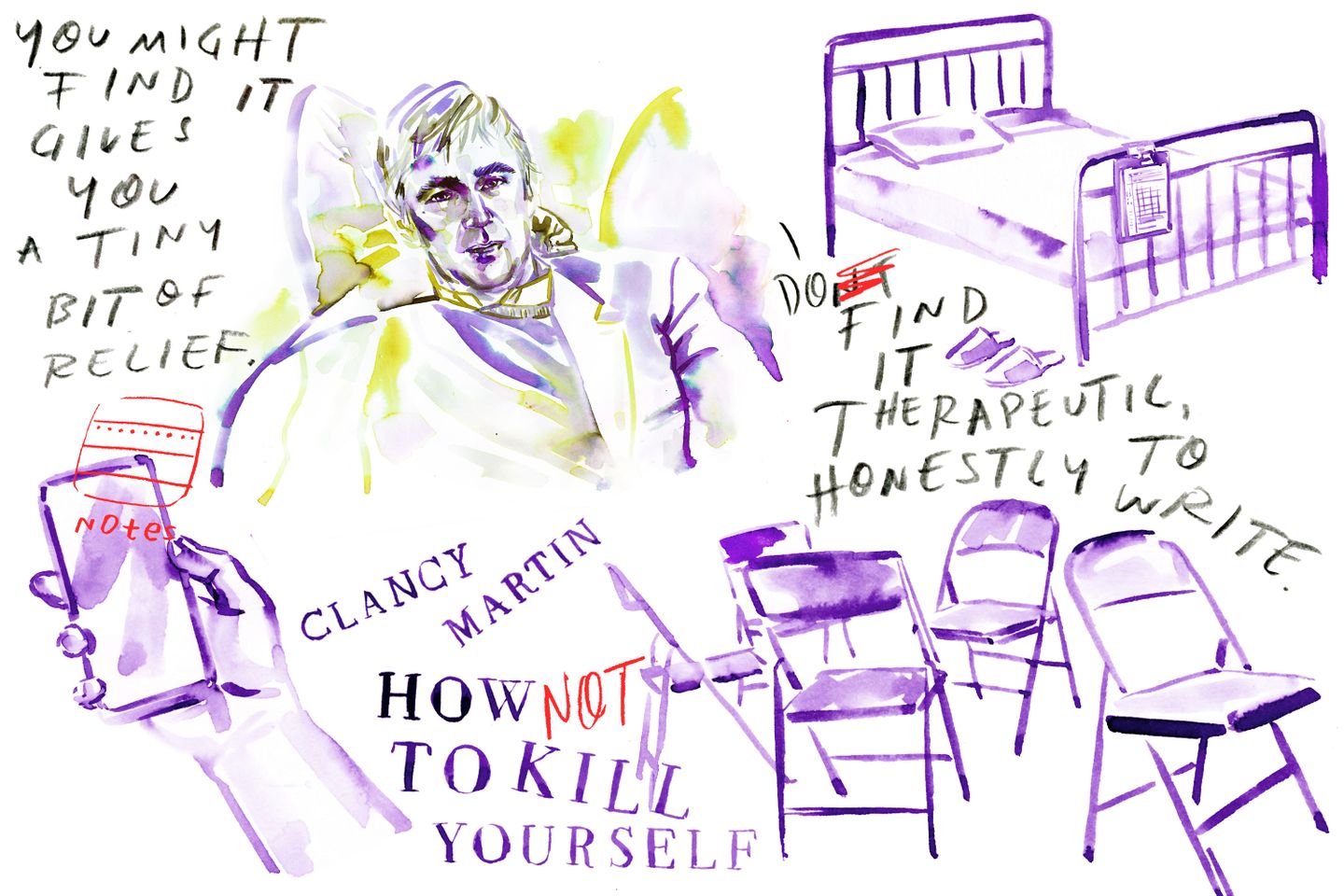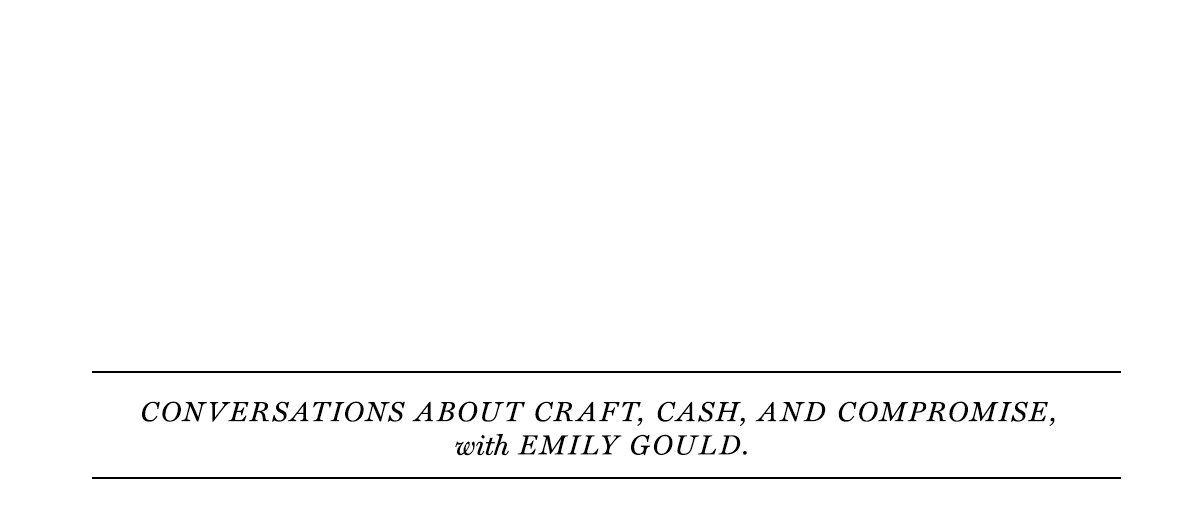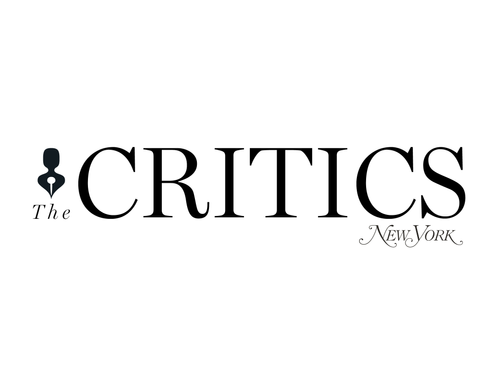 | ![]() | | Illustration: by Samantha Hahn | | |  In the preface to his forthcoming book How Not to Kill Yourself, philosophy professor Clancy Martin writes, “I’ve lived all my life with two incompatible ideas in my head: I wish I were dead and I’m glad my suicides failed.” This sets the tone for the book, which encompasses philosophical and literary musings about the history and meaning of suicide as well as detailed autobiographical accounts of Martin’s own struggles with his mental health, addiction, and suicidality. |
| Martin, in person, is surprisingly upbeat, the kind of person whose default facial expression is a smile. The 55-year-old lives in Kansas City with his partner and children. It’s hard to believe he’s the same person who has survived at least six suicide attempts, let alone made that the focus of a book. And yet, as Martin explains, cognitive dissonance is one of the things that make “human beings the extremely interesting creatures that they are.” |
| A book called How Not to Kill Yourself is not only tough to read on the subway in hardcover, it also seems, at first blush, possibly dangerous for a depressed or suicidal person to read. But even as Martin spares no detail about his depressive episodes or suicide attempts, the book lives up to its ambitious title. Inherent to the hopeful message is Martin’s overarching philosophy that we as a society must eliminate the idea that suicidal or depressive or addictive people are bad or sinful, an idea that’s baked so deeply into our culture we may not even realize it’s there. (He also includes an extensive appendix of self-help resources.) |
| The book itself grew out of an essay in Epic magazine that Martin began to write about his time in psychiatric hospitals, which came to encompass the suicide attempts that had preceded them. “I don’t know why it didn’t occur to me to write about it before. This is something I’ve been thinking about all my life.” When the piece came out and was co-published with HuffPost, the response was overwhelming. Martin knew he had more to say on the subject, and for the next few years, including during the early pandemic, he began work on How Not to Kill Yourself. |
| Martin himself can’t help wanting to share his hard-earned wisdom with those who are currently suffering in the way he once was and — he’s open to admitting — may yet be again. In an earlier version of the book, Martin also included his own email address, but was wisely stopped by his editor. He’s still a bit worried that he’ll be deluged by people wanting help when the book is published. Often, depressed people do reach out to him. He always tries to always answer. He mentions a mentor, John Draper, who has worked in suicide prevention for over three decades, who told him, “It doesn’t matter how much training I give my people, none of that training is at the end of the day as powerful as having gone through the experience yourself and made an attempt.” So he responds to his correspondents, even if just to say, “Hey, thinking about you, wanted to check in.” |
| The kind of personal writing that Martin does in this book is extremely raw and, I assumed, difficult. He describes not only his suicide attempts but also time spent in the psychiatric ward and marriages gone awry, including wrenching supervised visits with his now-older children from his first and second marriages. “The hardest parts, as I’m sure you’ll understand, are the parts that involve my children,” he admits. Recording the audiobook was especially brutal. But the other parts — such as writing a chapter about his time spent in various psych wards — weren’t as painful, Martin says. “I do find it therapeutic, honestly, to write and remember what happened. It’s easier to forgive myself, but it also has to do with having a sense of humor. You’re more somebody who’s slightly ridiculous than you are somebody who’s so evil or whatever.” |
| In one of the most affecting parts of the book, Martin describes how writing, even when extremely depressed, is one of the things that helps him, even the simplest sentences like: “Just get through today.” I told him how much this resonated with me, and he emphasized that he thinks this kind of minimal effort is important. “I always tell people, just do what I do. Just tap it into the notes section of your phone, and you might find it gives you a tiny bit of relief. I don’t know why exactly it does, but for me it does.” |
| The most controversial chapter of the book, “Drinking Myself to Death,” was published in part in Harper’s in 2011. His is the first account I’d ever read and perhaps the only one that exists of the various kinds of people you tend to meet in Alcoholics Anonymous. He’s frank and detailed about what he experienced at those meetings, including quoting AA members, though their identities are obscured. But even with that scrim of obfuscation, some of the members of his own group weren’t thrilled to recognize versions of themselves in print. (The group is, after all “anonymous,” a policy that arose at the program’s outset so that members could feel comfortable sharing even the most harrowing details of their lives in meetings.) “This one guy in particular who — I really liked him — threatened to come to my office with a baseball bat,” Martin said. He’s less worried about backlash this time around. “I do think in the last ten years or so even hardcore thumpers in AA are starting to rethink what we mean by anonymity and how the culture is changing. It seems to me that culturally speaking, and this may be a happy consequence of social media, we are more and more valuing destigmatization and openness.” |
| Martin’s issue with the central philosophy of AA is how it refuses the idea of a spectrum of substance misuse. “Based on my experience and that of friends who also suffer from chronic suicidal ideation, some of whom are also addicts,” he takes issue with the idea that you either are or aren’t an alcoholic, and that absolute abstinence works only for “some, but not a majority of people.” He also has a problem with how some groups reject the use of all psychopharmaceutical drugs. Still, despite what he sees as the flaws in AA, he doesn’t think he’d be a nondrinker now without it. Martin’s willingness to be at all publicly ambivalent about the program resulted in backlash that shocked him. He describes a conversation at a party with a famous recovery memoirist who, at a party, told him, “Nothing needs to be changed about AA,” turned on her heel, and walked away. |
| The crux of Martin’s philosophy about addiction is the same as his philosophy about mental illness: rejection of “on/off thinking.” “When it comes to my depression, my anxiety, my addictions, my suicidal thinking, there’s no great emancipation from these things, and there’s no terrible curse of these things.” It’s an observation that carries weight when you’ve read about Martin’s stays in the psych ward, which he describes in detail, down to the slippers he wore and the people he met there, comparing the scars on their wrists. Nowadays, though, he is able to look at these experiences at a remove, and to practice a kind of radical self-forgiveness. “If I do have a relapse, and I’ve had plenty of them, I’m not recommending them, I’m just saying, ‘No, okay, you had a relapse,’ and then it doesn’t feel like such a big deal to get back on the wagon.” This is in contrast to what he sees as a “moralistic way of thinking: Either you’re a sinner or you’re saved. I really think that’s part of the problem.” |
| The same philosophy applies when it comes to self-harm. When Martin talks to his philosophy students, he’s open with them about his attempts. “Everyone at some point in their life goes through a time when they think it would be easier just not to live at all. And a lot of people have this kind of chronically in their heads. And I explain to them a little about that. And then I say, ‘And I just want to tell you that I’m here for you.’” |
| In the U.S., the National Suicide Prevention Lifeline can be reached at 988 (call or text) or 988lifeline.org (chat). |
| Enjoying Making It? Forward it to a friend. Or sign up for The Critics, a newsletter surveying the week in culture. You may also like Brooding, a newsletter delivering deep thoughts on modern family life. |
| | |





